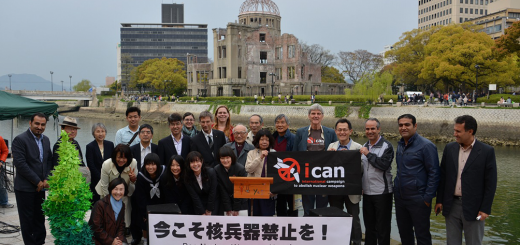Group Introduction The Committee to Consider Pluthermal and Saga Prefecture’s Next 100 Years Nuke Info Tokyo No. 128
By Hatsumi Ishimaru*
 |
|
Collecting Signatures
|
The Genkai nuclear power station is located in the north west of the island of Kyushu on the tip of Saga Prefecture. With a population of 8,000, Genkai Town is situated in a rich natural environment facing the Japan Sea.
When Kyushu Electric Power Company submitted a request to the Prefectural government in 2004 for prior approval of its pluthermal plan, a petition was submitted by over 300,000 people from all over Japan calling for the plan to be abandoned. After Governor Furukawa declared on February 7, 2006 that the plan was safe, we set up camp outside the prefectural offices and held a parade to express our opposition. Saga Prefecture citizens collected over 20,000 signatures in just two weeks, but on March 26, 2006 the governor gave his prior consent for the plan, declaring that the public’s understanding had been obtained. We immediately began a campaign for a prefectural referendum ordinance and two months later submitted 53,000 signatures (three times the two percent of voters required to demand such an ordinance) to the Prefectural Assembly.
In January 2007 an extraordinary session of the Prefectual Assembly was convened to consider the issue, but the bill for a referendum ordinance was overwhelmingly defeated by the combined forces of the Liberal Democratic Party and the New Komei Party. They said that a referendum about pluthermal would “negate the existence of the prefectural assembly” and would be “a departure from indirect democracy”. They also said, “The assembly will make a carefully considered judgment. Citizens are not capable of making a comprehensive assessment of the effects of pluthermal.” The governor said, “It cannot be concluded that a referendum in which prefectural residents decide directly on this important issue is necessary…Referenda are appropriate where the citizens’ representatives have debated an issue but cannot reach a decision, or for issues which relate to the very existence of the prefecture, such as a proposal to change the prefecture’s name. However a referendum is not appropriate for pluthermal.”
Nevertheless, the referendum campaign achieved some things. It generated widespread public interest in the pluthermal plan. People who had carried the campaign against nuclear power for many years were joined by people who became involved for the first time due to their concerns about pluthermal. Together they formed the “Committee to Consider Pluthermal and Saga Prefecture’s Next 100 Years”. Since then, the Committee has been working to inform the residents of Saga Prefecture about pluthermal, raising it as an issue for the whole prefecture.
Although Genkai-3 is scheduled to become the first nuclear power plant in Japan to implement pluthermal, many people are continuing to raise concerns about issues of safety, economics, and whether pluthermal is necessary in the first place. Another reason why people are concerned is that no decision has been made about what to do with the spent MOX fuel. Also they are concerned because Japan is a very earthquake-prone country.
We refuse to accept the implementation of pluthermal. People in Saga Prefecture and throughout Japan, generations born and unborn, will be forced without their knowledge to live in a land which is radioactively contaminated. It is the responsibility of today’s adults to take action now.
They say that Genkai’s pluthermal plan will be implemented in 2010, that MOX fuel has already been fabricated and that the project is going forward step by step. However, we have not given up hope and will continue to do what we can to block the plan.
*Hatsumi Ishimaru is a member of the Committee to Consider Pluthermal and Saga Prefecture’s Next 100 Years.

